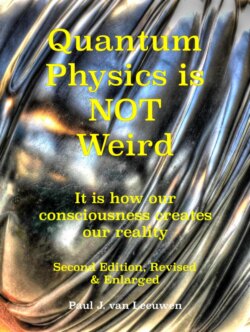Читать книгу Quantum Physics is NOT Weird - Paul J. van Leeuwen - Страница 10
На сайте Литреса книга снята с продажи.
The geocentric Ptolemaic model
ОглавлениеAristotle (384 BC – 322 BC) created one of the first known geocentric models of our universe of the western world. The Greek philosopher conceived a cosmos with the imperfect earth at the centre, surrounded by perfect celestial bodies, each one attached to its own perfectly circular revolving transparent sphere. The stars had their home on the most outermost and in approximately 24 hours revolving sphere.
Figure 2.1: Aristotle’s Universe.
Source: Wikimedia Commons.
Down here on imperfect earth all movements were also imperfect, which means they were rectilinear as opposed to the perfect circular movements in the heavens. A cast stone was supposed to travel in a straight line to right above the location where it would fall and then, upon arriving there, supposed to fall straight down. That a keen observation would show otherwise was no problem apparently, people clearly observed what they thought they should see. Phenomena, of which they 'were sure' that could not happen, were not observed. This is a very common human psychological trait. Aristotle’s geocentric model of the cosmos was unsatisfactory, it could not explain the seemingly backwards (retrograde) movement of the planets in their paths through the heavens.
As an echo of things to come, Aristotle also coined the word "hylomorphism", a concept which says that every individual experienced thing is a combination of substance, matter, and form. Form has no material cause but originates from potential. Change and manifestation is caused by the transition from potential to action. With this idea Aristotle seemed already to be on track toward quantum physics, as we shall see.
Hipparchus (about 190 BC – 120 BC) improved on the Aristotelian model by means of epicycles. According to Hipparchus each planet moved in a circular orbit – the epicycle – around a fixed point on its appointed revolving sphere, the deferent. These epicycles explained the erratic retrograde movement. Hipparchus also calculated the distance from the earth to the moon and even to the sun. His achievement was not very far from the mark.
For an idea of the functioning of an epicycle, see figure 2.2. The big circle is the deferent representing the revolving sphere. The arrow indicates the direction of the main revolving movement of the deferent. The small circle in the middle represents the earth. The lesser circle with its centre, a dot, positioned on the deferent is the epicycle. The planet revolves along the epicycle in the direction of the arrow while the centre of the epicycle revolves along the deferent.
Imagine a children's bike wheel with its axis attached to the rim of a normal bicycle wheel. Try then to imagine how the valve of the smaller wheel will move if you set both wheels moving. The valve of the small wheel represents the planet, and the axis of the larger wheel represents the earth. So, if the planet moves from position 2 to 3, it will be, as observed from the earth, seem to be moving backwards. Like sitting in a fairground teacup carousel [1] with sets of three or four teacup gondolas revolving around a centre that in its turn is also revolving around the centre of the carousel. Standing in the middle of the carousel you will see people in the teacup gondolas moving backwards at times. The geocentric cosmos with its epicycles can be seen as a very large carousel with planets as teacup gondolas.
Figure 2.2: Planet movement in epicycles, small circles, around the deferent, the centre of the bigger circle is the earth.
Source: Wikimedia Commons. Author: M.L. Watts.
Claudius Ptolemy (87 AD – 150 AD) improved further on the epicycles of Hipparchus by placing the earth a little bit off-center as regards to the deferents. He created in fact the simulation of an ellipse. Thus optimized, the complex Ptolemaic model had reached a forecasting accuracy which was correct within a few percent. This amazing accuracy could be the reason that, despite its complex calculations, this – from our current viewpoint – ostensibly wrong planetary model, lasted from its introduction until its abolition for almost fourteen centuries. Which is understandable when you consider that predictability of the world is a much-valued feature.
For a visual demonstration, you may enjoy the Ptolemaic System Simulator [2].
